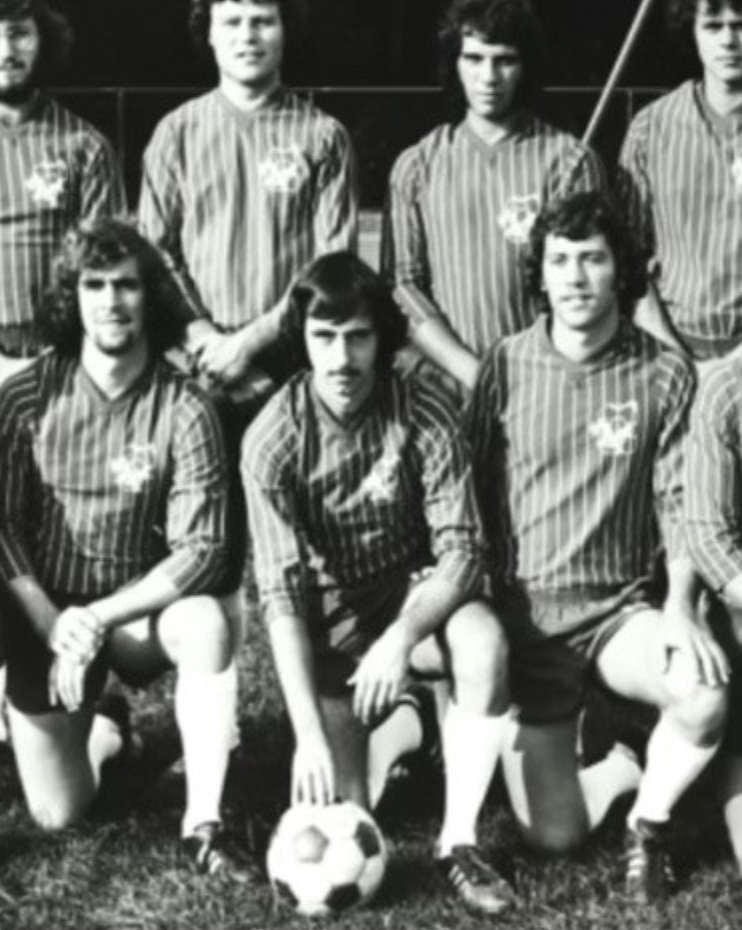Commentary: The history behind why Americans don’t play soccer
Commentary: The history behind why Americans don’t play soccer

When I was a kid, my dad tried recording important Champions League games on our VCR to watch them when he returned home from work. My friends and I, home from school by then, were given strict instructions to not touch the television, VCR, or remote under any circumstances because it would mess with the recording.
We regularly touched all three.
So, my dad would come home to a recording of someone flipping channels and watching “Drew Carey Show” reruns instead of, say, the 2005 Champions League Final. Inevitably, my dad got mad. But not because I was disobeying him – he was probably used to that by then – but because now he’d never get to watch the game. It wasn’t that his son had done something wrong, rather, that I had majorly inconvenienced him. Even in 2005, if you lived in America and missed the live broadcast of a soccer game, you never saw any of it again. No highlights, no analysis, no postgame interviews—nothing.
After all, it was just soccer. It’s not like anyone cared.
If you’re from a “soccer country” and grew up in America, you accept it as a fact of life that no one likes soccer. But if you’re an aspiring soccer journalist, writing a capstone project for a master’s degree in sports journalism, you might not simply accept that fact. Instead, you might ask yourself, ‘why is that the case?’ Why does a sport that every country likes and follows — there are more members of FIFA (211) than the UN (193) — not have any foothold in America?
One of the sport’s defining characteristics is that Americans don’t like it. And while disliking soccer is not one of America’s defining characteristics, it is still one of them. On par with peanut butter and yellow school buses. It’s not the most important thing about America, but something the rest of the world considers only to happen in America and, perhaps more notably, that Americans don’t realize the rest of the world considers an endearing but wholly unrelatable peculiarity.
There are other sports that aren’t as popular in America as in other countries — cricket, rugby, Aussie rules football, even hockey. The difference is that those sports are unpopular in other countries as well. Cricket isn’t popular in Ecuador, and hockey isn’t in Tunisia. So, the popularity of those sports could likely be attributed to a cultural phenomenon specific to those countries and/or regions. But for America the cultural phenomenon gets reversed, its not about why a country loves one specific thing rather how can it be so disinterested in something that everyone else loves.
Soccer writer Brian Phillips attributes much of the resistance and outright hostility of the past to America’s general preference to export culture rather than import it. This element of the American psyche and self-imagination is certainly part of it, but it can’t be all of it because soccer spread around the world at the turn of the 20th century. Some 40 years before America’s entertainment and commerce enveloped the postwar globe.
It could have been America’s general resistance to the immigrants that played the sport and the expectation that they assimilate to American culture rather than contribute to it. While this part is even more true than Phillips’ analysis, I thought it still lacked specificity. It was too broad a theory, one that didn’t address soccer specifically but rather just treated it as a function of broader American socio-cultural trends. More towns in America have a Chinese food restaurant but not a soccer bar. So why did some elements of immigrant culture interweave themselves into American culture, despite their initial struggles? There had to be a specific reason people didn’t like this thing that other people brought to America.
Those reasons ultimately were caused by large-scale structural choices that were either a result of or caused by American cultural and ethnic nativism. These expansive decisions affected public broadcasting, which never held the same role it did in the public consciousness of other countries and the decision to hand over youth sports to academic institutions, meant only those who attended them were afforded access to organized sports. Both of these immovable forces would then be buttressed by the desire to develop a domestic league at the expense of promoting elite soccer from Europe.
When broadcasting executives, sports historians and longtime American players talk about soccer’s failure to launch, a seemingly cyclical question emerges. Was soccer unpopular because it was never on TV or was it never on TV because it wasn’t popular? It’s the proverbial chicken-or-the-egg for sportswriters interested in the history of American soccer. Answers are mostly anecdotal, from long tenured sports media figures, like veteran producer Jerry Steinberg, but one thing is clear: soccer wasn’t on, until suddenly it was.
“Maybe, if there was a decent American team, you saw some qualifying stuff on maybe on ESPN or someplace,” Steinberg said in his vintage New York accent. “But it wasn’t like baseball [that] was on like, all week long or football every Sunday or basketball all week long.”
Steinberg started working on soccer broadcasts in the mid-1980s, across all the major channels – ABC, CBS, NBC, ESPN, and FOX. His career also includes being part of the founding team of both ESPN, in 1979, and, FOX Sports, in 1994.
The reason soccer suddenly appeared on American television screens was the same reason all programming decisions that once seemed inconceivable — 24-hour news, reality TV — were made: there were more channels. So, executives needed to fill more hours of television and looked for the most efficient ways to do it. One of which was showing more of what they already had the rights to.
“They [broadcasters] had these sports contracts that they had done with organizers, leagues, etc.,” explained Dennis Deninger, who led ESPN’s coverage of the 1994 World Cup. “They realized that there was more content than they had hours on ESPN. So, if we [ESPN] started another network, we’ll be able to sell advertising in more programs that we can put over on ESPN2, and we already have the rights to this content.”
Deninger recently wrote “Sports on Television: The How and Why Behind What You See,” a book about the evolution of sports broadcasting. He also launched ESPN’s coverage of Major League Soccer (MLS).
Disney launched ESPN2 in 1993 before soccer was popular in America by any hard or soft metric.
But there’s another, much more practical reason that soccer wasn’t on television before the proliferation of cable television. It didn’t have any timeouts, which meant no stoppages in play, which meant no commercial breaks, which means no ad sales. Something that seemed to baffle American producers, whose initial solution was to simply go to commercial anyways. Eventually, they came to their senses and stopped doing that before deciding to prioritize more popular, regional American sports with their appetizingly lucrative ad breaks.
If American television companies were concerned about losing out on advertising sales during soccer games, wouldn’t it stand to reason that companies in other countries might feel the same? The answer is they did. But what other countries had that America lacked was public broadcasting; channels that didn’t need to rely on ad revenue because they had government funding.
“When opportunities to broadcast soccer games first appeared [the American broadcasting industry] was dependent on revenue from commercial advertising,” explained Ted White, author of the book “Soccer in American Culture: The Beautiful Game’s Struggle for Status.” “That was not the case in the UK where radio and television were operated by the government. Thus, the BBC could broadcast or televise soccer matches without commercial interruption – In contrast, US broadcasters wanted interruptions in the flow of play to insert commercials and struggled to achieve that.”
For someone like me — who grew up thinking (knowing) soccer was the most important sport in the world — it’s still impossible to imagine what soccer in America was even like before it was at least considered a weekend leisure activity for elementary schoolers.
I first met Don Ridall when I interviewed him about his retirement after 46 years as the head coach of the Pebble Hill School boys’ varsity soccer team in Manlius, New York. I’ll be honest and say I didn’t know anyone in America played soccer 46 years ago. I mean, no one in France played basketball 46 years ago, right?
Ridall started playing soccer in the late 1960s in Upstate New York, had a collegiate career at SUNY Cortland and then took up coaching almost immediately thereafter. He’s been in soccer his whole life. More importantly, he’s been in American soccer his whole life.

“There really weren’t even recreational leagues — imagine Little League how big that was back then — there really wasn’t anything for soccer at all,” Ridall said. “It was strictly, come the fall season you played soccer and then you put the balls away and you didn’t touch the ball again until the season started again next year.”
When Ridall first tried to nourish his burgeoning passion for the game, it was hard to find much sustenance to keep it alive. There was only one game a year on television — “always Brazil” he says — and any soccer magazines could only be found in major urban areas. Certainly not in Central New York where he grew up.
So, between when Ridall started playing and caring about soccer and now, there was a period when the American public knew about soccer enough to warrant magazines and an annually televised game, but didn’t care enough to buy the magazines or watch that game. Soccer went from being unfamiliar to simply uninteresting. This seemingly inconsequential transition happened because sports broadcasting executives realized they were missing out on what soccer had to offer.
“Everybody knew the numbers of the World Cup,” Geoff Mason declared. “Everybody knew it was popular.”
Mason is another sports production legend. He’s good friends with Steinberg and cited both Roone Arledge and current Syracuse Athletic Director and former ESPN executive, John Wildhack, as mentors, quoting both of them throughout our interview. He started covering soccer for American audiences with the FA Cup Final “all the way back [in] the 1980s”.
As Mason tells it, those working in television were never hesitant or even resistant to soccer in America. They were professionals who understood their mandate to deliver entertainment to viewers and value to shareholders. Although, some opinions were less favorable to soccer, such as this, this, and this. So, at the very least, maybe we could say that the people behind the camera knew it was a worthwhile investment.
“That is the point that the networks and the distributors of content in the United States have always done,” Deninger said. “[They say] okay, we can expand your reach into the US market, we can do it this way, we can possibly give you access to new advertising to new viewers, to new sponsors who might want to be part of your signature events.”
The symbiosis between leagues (in soccer’s case from multiple countries) and broadcasters culminated recently in a spate of unprecedented rights deals; meant precisely to deliver this much sought-after American audience to the global soccer marketplace. ESPN reportedly secured the Bundesliga for $180 million over six years and La Liga for $1 billion over eight years. While Paramount+ signed three years deals with the Serie A for $225 million and the Champions League for $450 million. What these deals represent is a commitment to the game at its highest level; to approaching it and consuming it on its own terms, where it was already being played at its highest levels, i.e., in Europe.
Interestingly, the most recent US deal saw Apple purchase the MLS rights for $2.5 billion over ten years. But the willingness to pay $250 million per season — 67% more than Paramount’s annual Champions League fee — is emblematic of either one of American soccer’s endearing quirks or inhibiting obsessions: the desire to create a competitive domestic league. Apple’s new deal might give the impression that this approach was imperative to the game’s development, but its probably just as much a function of Apple’s willingness to spend its cash reserves on content for its nascent streaming service. It did after all, spend $45 million on “Foundation” — an acclaimed television show that no one in my life has mentioned to me even once.
The need to create a domestic league sounds logical on paper but seems less so when you consider that a country with virtually no soccer expertise might not be suited to displaying the beautiful game’s, well, beauty. Developing a competitive league can help but its not more important than developing a talent pipeline to Europe. Getting fans to watch local teams is an obvious way to create an immediate, if temporary bond, but it doesn’t make for a better product than La Liga, the Premier League, or Serie A. Give the people the good stuff even if they don’t yet know it’s the good stuff.
It is worth mentioning that most other countries weren’t as sealed off geographically from the soccer world as America and, more importantly, didn’t represent such a lucrative, untapped market. There are 110 million households in America who are used to rooting for local high school and college teams and have comparatively high disposable income. Trying to capitalize on that fandom isn’t a foolish business idea, it just might benefit from a helping hand from (gasp) Europe.
This same self-absorption was present from the earliest moments of soccer in America in the 1890s when it was still an immigrant sport played mainly in ethnic neighborhoods.
“There was no established community of people that had a familiarity with the sport except pockets of recent ‘immigrant’ cities or towns where recent arrivals had come from the UK,” said White in an email. “So, when soccer started to be played in the US, recent immigrants were engaged in it.”
There’s much more I could write about the history of immigration and the processes of assimilation to American culture that would extend far beyond soccer. But it is an unavoidable part of the story: the game wasn’t popular because the people who played it weren’t popular.
Even though it may seem too long ago for it to have had any actual impact on a sport’s popularity in contemporary America, this specific trend was happening precisely at the same time as American high schools and colleges took over youth sports in the 1910s and 20s. According to White, many of those immigrant families didn’t go to college, which was where major sports were played at the time.
“In the meantime, some “indigenous” American sports began to develop, such as gridiron football, basketball, and volleyball,” White said. “Those were the sports that high schools tended to offer. That emphasis had a ripple effect on colleges and universities, resulting in fewer persons attending those institutions with experience playing soccer.”
The ripple effect extended beyond just the early 20th century through the sport’s development, in that it became primarily played by American athletes trained by American coaches. Both of which had limited expertise. When Ridall played, he remembers it as an entirely American sport with no international players despite its global nature.
“It was not international at all,” Ridall laughed. “In fact, our whole team [at SUNY Cortland], we all were from New York State. To us, the foreigners on the team were the kids from Long Island and to the kids from Long Island, we were the hicks from upstate.”





